21 Common Types Of BEACH BIRDS (ID Guide With Photos)
Did you recently come across a bird on the beach? In that case you’ll probably want to know what species you saw.
Identifying coastal birds is not as easy as it might seem, since there are surprisingly many species of birds found in this habitat in North America.
To help you identify the bird you saw, we’ll cover the most common types of birds that can be seen at the beach in North America.
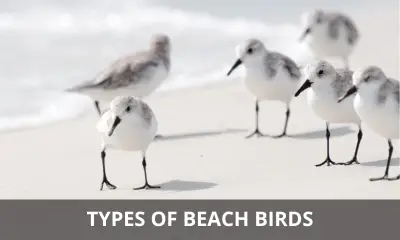
What are the types of beach birds in North America?
There are 21 types of beach birds commonly found in North America, which are covered in full detail below.
They belong to the following categories: seagulls, terns, shorebirds, herons, ibises, spoonbills, flamingos, cormorants, pelicans, and skimmers.
Now let’s dive into the details, and take a closer look at these birds:
Seagulls
Laughing Gull
Scientific name: Leucophaeus atricilla
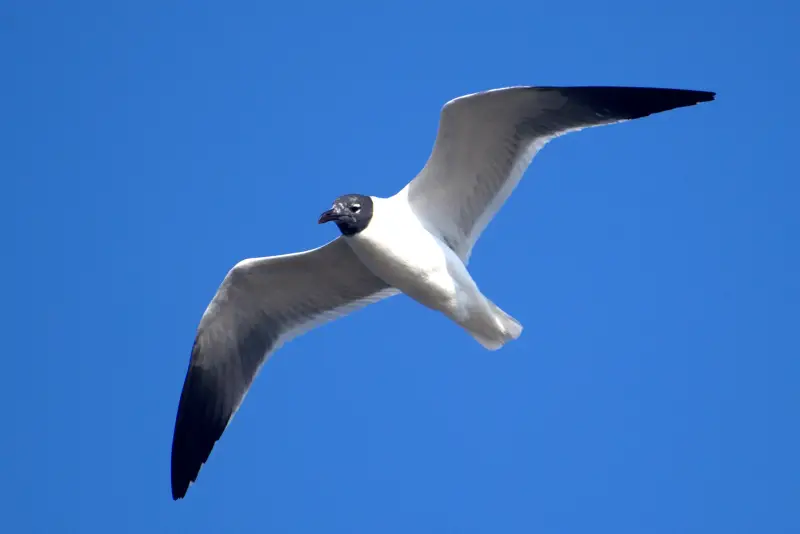
The Laughing Gull is a common seabird along the entire Atlantic coast of the United States, and can be easily identified by its black head and its loud call that resembles human laughter.
Adult Laughing Gulls in summer are largely white with a black head and gray upperside. Both the bill and the legs of this seagull are dark red. In contrast to adults, juveniles are pale gray brown.
Laughing Gulls are most common close to mud flats and sandy beaches, but these seabirds also occur away from land, foraging over open water.
These common seagulls are white seabirds that live in North America year-round.
Outside of the breeding season, these seagulls are sometimes also observed further inland on rare occasions, showing up at lakes and reservoirs.
Herring Gull
Scientific name: Larus argentatus
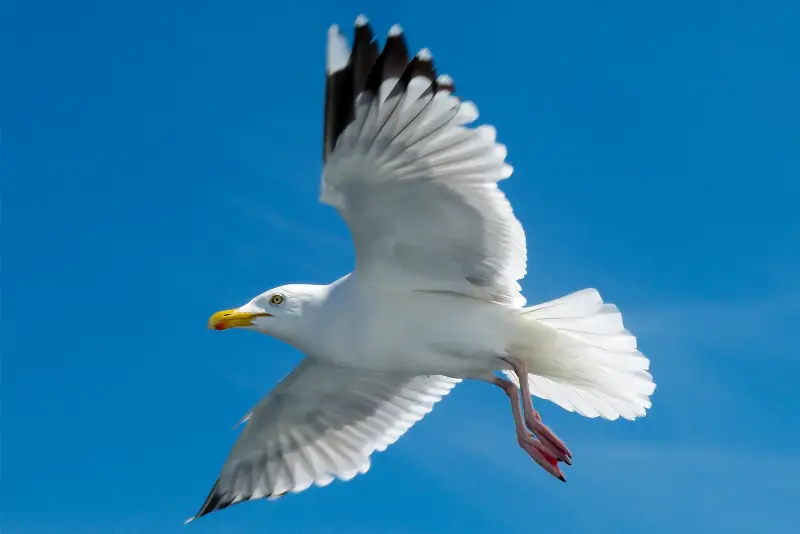
The Herring Gull is a widespread winter visitor along the entire North American coastline. Similar to other seagulls, it is a scavenger, and likes to frequent landfills and garbage dumps.
This is a large seagull with a white head and underparts, as well as a pale gray mantle and black wing tips. During the winter it has gray speckles on its neck and head.
Apart from scavenging, it also feeds on fish, mollusks, and crustaceans.
It is a very intelligent seagull, and likes to drop shellfish from a great height in order to crack their shell open and feed on the soft interior.
Terns
Royal Tern
Scientific name: Sterna maxima
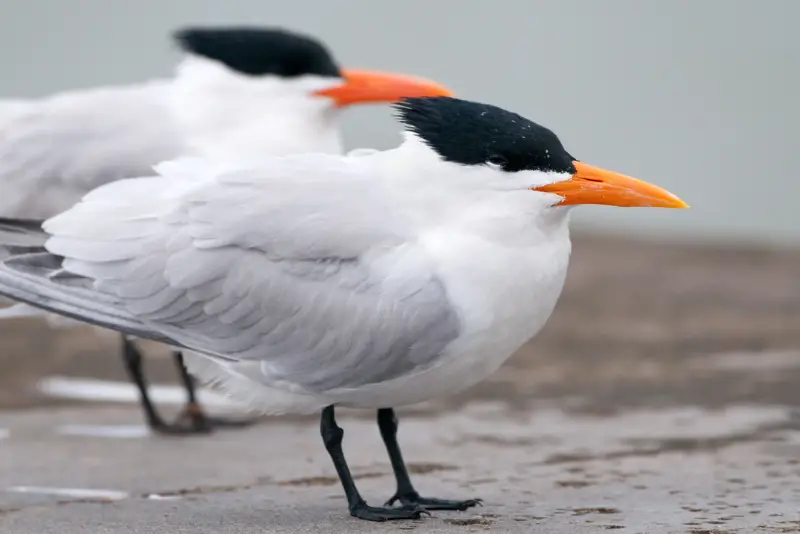
The Royal Tern is a seabird breeding along the beaches of the eastern United States, and winters along both the east and west coasts.
During the winter, the Royal Tern population in the Gulf of Mexico and along the coast of California swell due to an influx of migratory birds that arrive from the north.
During the cold months, these beautiful terns can be seen along the entire coast of southern North America. They hunt small fish by plunging head-first into the water.
Forster’s Tern
Scientific name: Sterna forsteri

The Forster’s Tern is a medium sized seabird that is a common breeding bird along the coast of eastern North America, and winters along both coasts.
Adults are almost entirely white birds, except for their gray mantle and black cap. Their orange beak has a black tip.
In its non-breeding plumage, it loses most of its black cap, but can be identified by a characteristic comma shaped black eye patch.
The main breeding habitat of this seabird are shallow seaside waters, including bays, inlets, and tidal flats.
In addition, Forster’s Tern may be encountered breeding in a range of freshwater settings, most frequently at lakes and reservoirs.
Shorebirds
The category of shorebirds is vast, encompassing more than 90 different species (including sandpipers, stilts, curlews, godwits, yellowlegs, woodcocks, snipes, stints, turnstones and phalaropes).
For the sake of simplicity, we only included the species that are most commonly encountered on the beaches of North America:
Sanderling
Scientific name: Calidris alba
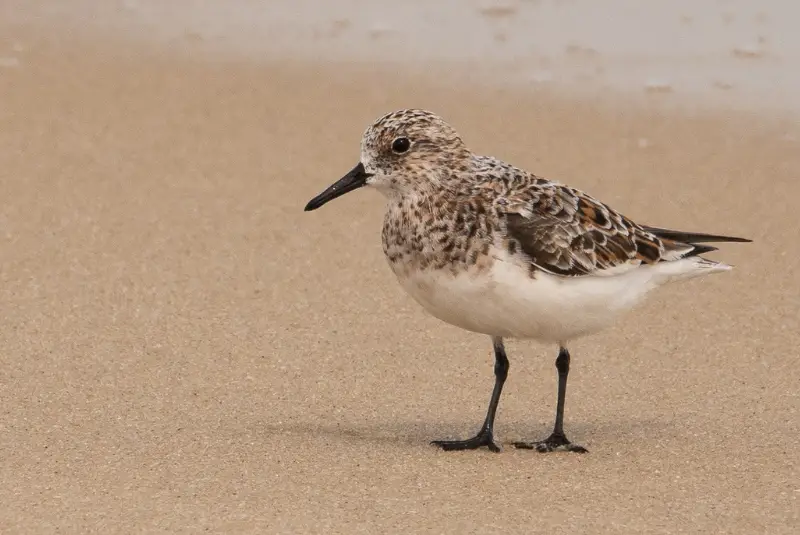
The Sanderling is one of the most common coastal birds in southeastern North America during the cold months, where it can be seen wintering from late August to April.
During the winter the plumage of Sanderlings is mostly white, and at this time of the year it is the lightest small wading bird on the beach.
The white stripe on its wings is only seen when it takes to the air.
Sanderlings like to forage in small groups on beaches, and run along the beach with surprising speed. They feed on small animals that are exposed by the breaking waves.
Another great characteristic for identification of Sanderlings are the white wing stripes, which flash brightly when it flies.
Spotted Sandpiper
Scientific name: Actitis macularius
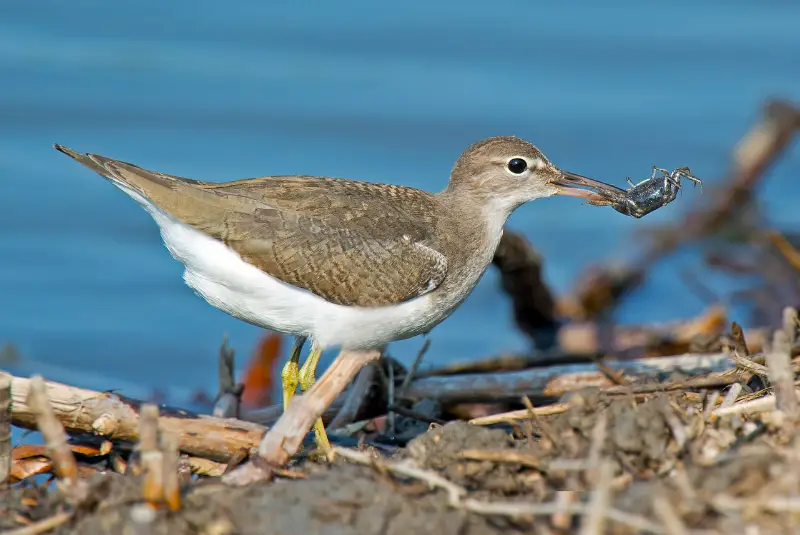
The Spotted Sandpiper is a common wintering bird along both coasts of North America, where it can be found on the edges of creeks and estuaries.
During the winter this sandpiper has a brownish gray upperside, which contrasts with its bright white underside. A great way to identify it is by its constant bobbing of the tail.
The Spotted Sandpiper forages on banksides and muddy areas, where it picks up small insects and invertebrates from the ground.
Black-necked Stilt
Scientific name: Himantopus mexicanus

This wader is easy to identify by its striking black-and-white plumage coupled with long reddish pink legs.
With legs that are more than 9 inches long, the Black-necked Stilt has the longest legs of any bird in proportion to its body size.
This shorebird is a year-round resident along both the east and west coast, and Its preferred breeding habitat are shallow marshes, but during the winter it is also found at beaches along the coast.
American Oystercatcher
Scientific name: Haematopus palliatus
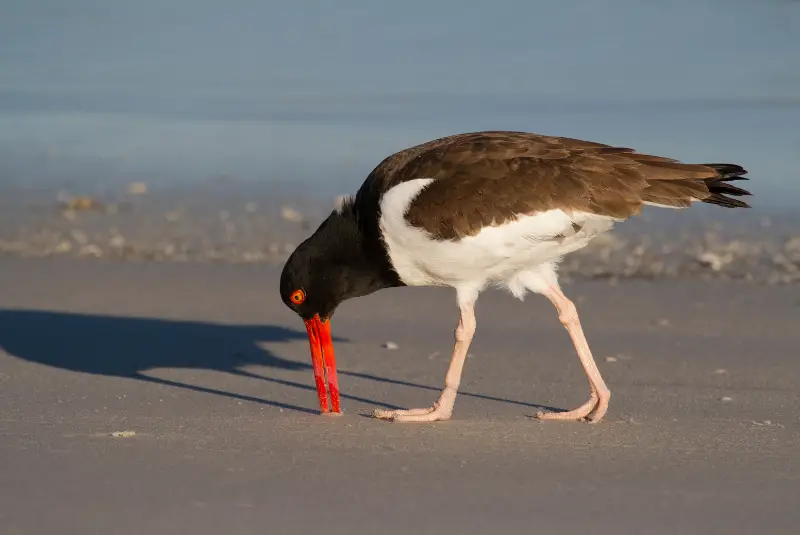
American Oystercatchers are beautiful beach birds with striking coloration. They have a jet black head and neck, which contrasts with a bright white belly and a long, heavy red bill.
The Oystercatcher is a wading bird of the tidal flats, where it follows the tidal patterns to feed on shellfish during low tide.
The heavy bill of the Oystercatcher helps it to pry open the shells of mollusks, and it also serves for hammering their shell until it shatters.
It is a year-round resident along the east coast, inhabiting the tidal flats and beaches of North America.
American Avocet
Scientific name: Recurvirostra americana
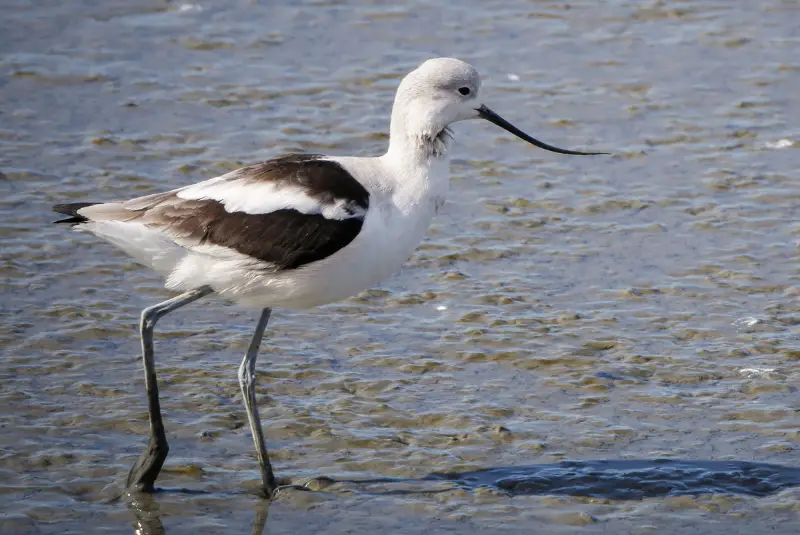
The American Avocet is another wader that doesn’t breed along the coast, but can be found wintering on beaches along both coasts of the United States.
These elegant birds have a long bill that is unusual in that it is curved upwards, which makes it unique among all the birds on this list.
American Avocets are often encountered together with Black-necked Stilts at beaches, coastal lagoons and mudflats.
Short-billed Dowitcher
Scientific name: Limnodromus griseus
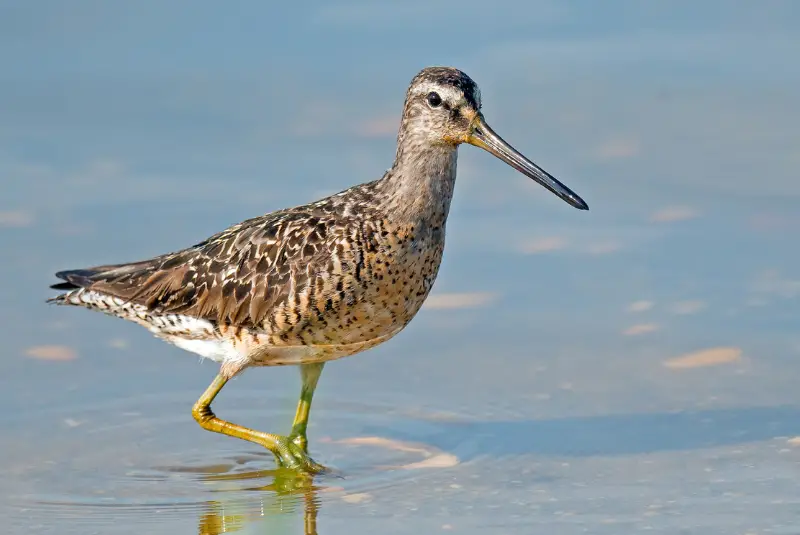
The Short-billed Dowitcher is a medium sized shorebird that is relatively easy to identify by its long, straight, dark bill.
It is a common winter bird along both coasts of North America, while its breeding grounds are found in the arctic tundra of Canada and Alaska.
During the winter it has a brownish-gray upperside, and white underside. During the breeding season, the throat and chest turn cinnamon orange.
This wading bird uses its long bill to probe for small invertebrates in muddy and sandy areas.
Black-bellied Plover
Scientific name: Pluvialis squatarola
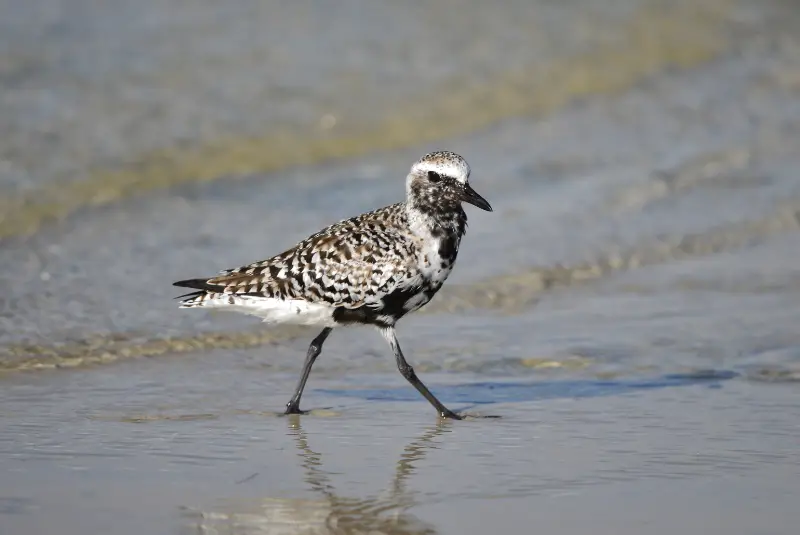
During the breeding season, the Black-bellied Plover is easy to identify by its striking black belly, breast, flanks, and face.
Outside of the breeding season, it is more drab, with white underparts and brown upperparts, and resembles a Sanderling in coloration.
However, it can be easily distinguished from a Sanderling by its much larger size.
This coastal bird is a winter visitor to North America beaches, where it can be seen from late July until April.
Willet
Scientific name: Tringa semipalmata
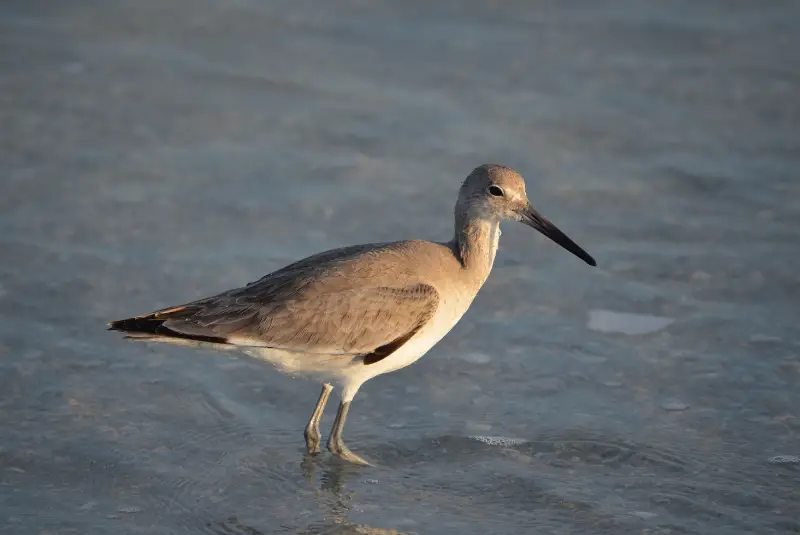
The Willet is common along both coasts of the United States during the winter.
It is a medium sized wading bird with a brown upper side and a white underside. During the winter, this beach only occurs in saltwater habitats.
When it takes to the wing, its conspicuous black-and-white wing markings become visible. It forages for small insects, worms, crabs, and other invertebrates along the ocean shore.
Whimbrel
Scientific name: Numenius phaeopus
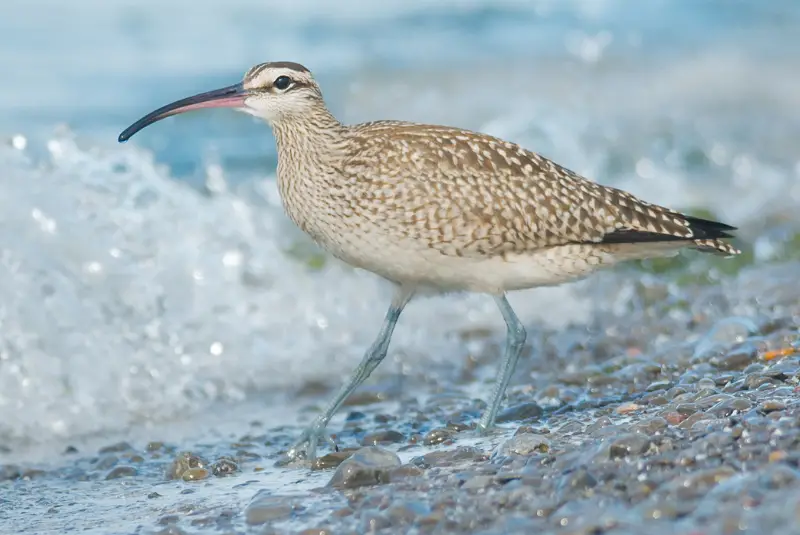
The Whimbrel is another large wading bird with a long downturned beak, and looks superficially similar to a curlew, but is smaller than the latter and has a slightly shorter beak.
These birds breed in the arctic tundra, but can be observed along the beaches of both the east and west coasts during the winter.
Whimbrels frequent mudflats, tidal estuaries, and saltmarshes, where their main food source consists of small crabs and other crustaceans.
Herons
Great Blue Heron
Scientific name: Ardea herodias
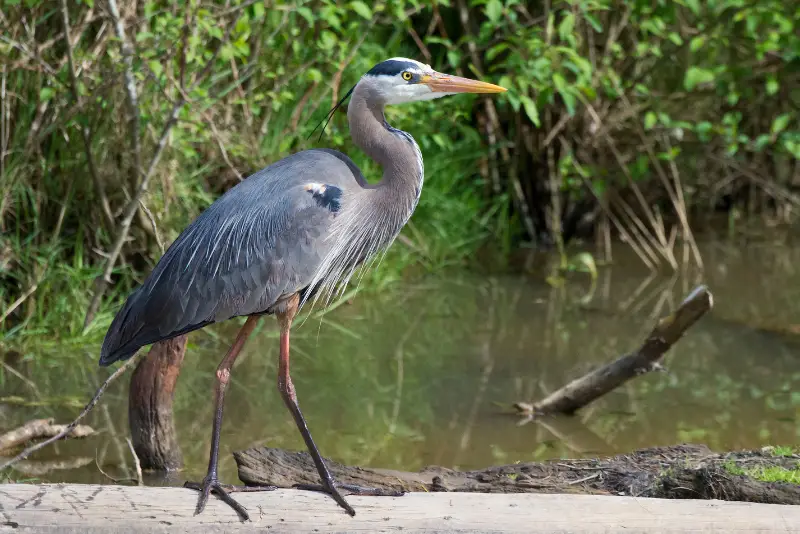
The Great Blue Heron is the most common heron species in North America, where it can be seen year round in most parts of its range.
It is a very large water bird with a wingspan of up to 6 feet. It is almost entirely blue gray, except for a white throat and eye stripe, as well as dark gray wing feathers.
This large heron likes to hunt for small fish by wading in the shallows of estuaries, beaches, mud flats and marshes along the seaboard.
It waits patiently for a suitably sized fish to come close enough to be grabbed with its long, yellow bill.
Tricolored Heron
Scientific name: Egretta tricolor
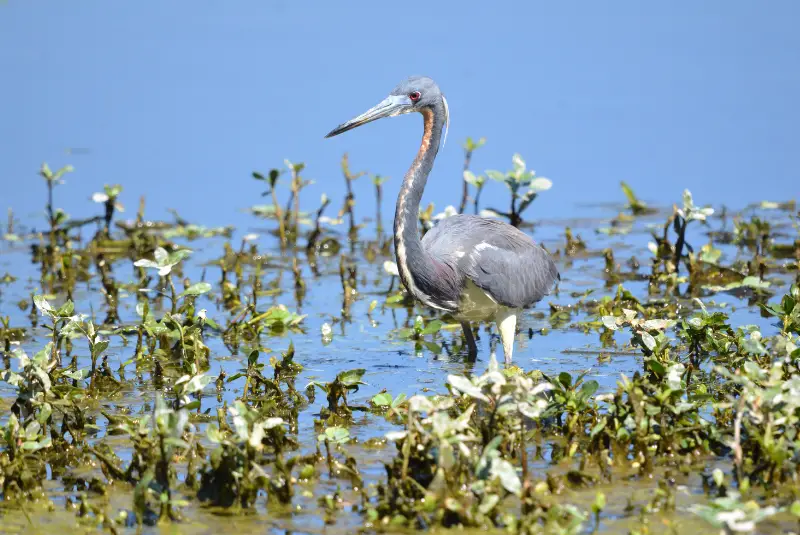
The Tricolored Heron is a medium-sized heron that has a blue-gray upper side and chest, as well as a white belly.
It is a breeding bird along the entire east coast, where it is most often found in estuaries and salt water marshes. It likes to nest in colonies, and sometimes forms colonies with other heron species.
This coastal bird hunts fish and invertebrates in shallow waters, usually by patiently waiting until its prey comes within reach.
Ibises
White Ibis
Scientific name: Eudocimus albus
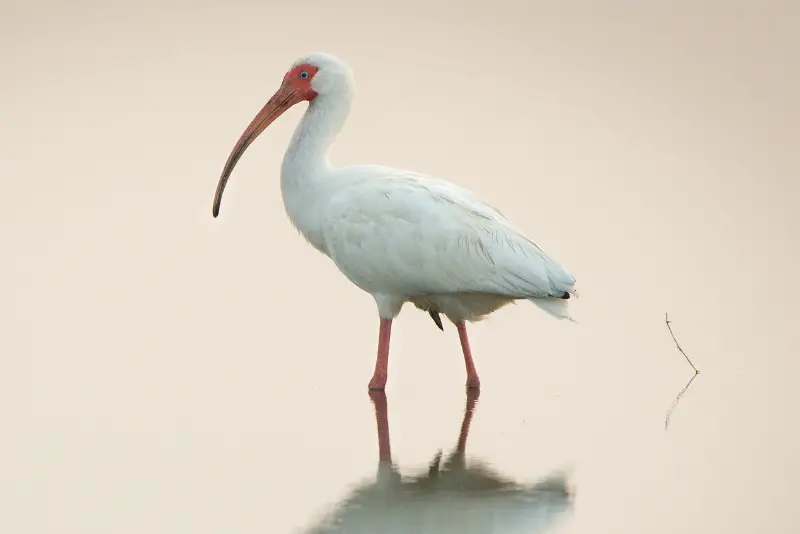
This aquatic bird is easy to recognize due to its entirely white plumage and long beak that is curved downwards.
The black wing tips are not really apparent until it takes to the wing.
During the first two years of their lives, immature White Ibises have a chocolate brown body with light streaks and a pale orange beak.
This bird is found in coastal areas along the southeastern seaboard, and feeds on fish, insects, crayfish, and other crustaceans. Crayfish form a large part of its diet in areas where they are common.
These aquatic birds nest in large colonies in forests located close to wetlands. They are extremely social, and like to forage in groups of 20 birds or more. In fact, it’s rare to see a solitary White Ibis.
Spoonbills
Roseate Spoonbill
Scientific name: Platalea Ajaja
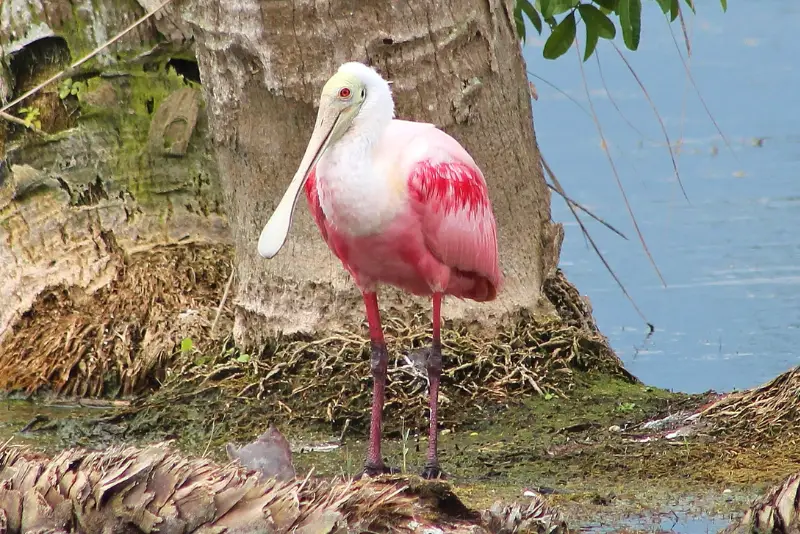
Roseate spoonbills are long-legged wading birds, similar to storks but smaller.
The adults are white on their backs, neck, and face, while the rest of their plumage is bright pink.
However, it should be noted that the exact shade of pink can vary a lot, depending on its diet.
The more shrimp it eats, the more pink its plumage becomes, due to the carotenoid substances found in shrimp.
These birds are sometimes mistaken for flamingos because they look similar, but keen ornithologists will notice that flamingos have a short, angled bill, while spoonbills have a long, spatulate bill that has a broad “spoon” at its end.
The best place to see these gorgeous birds in North America is in the Florida Everglades, which has more than 200 breeding pairs.
Flamingos
American Flamingo
Scientific name: Phoenicopterus ruber
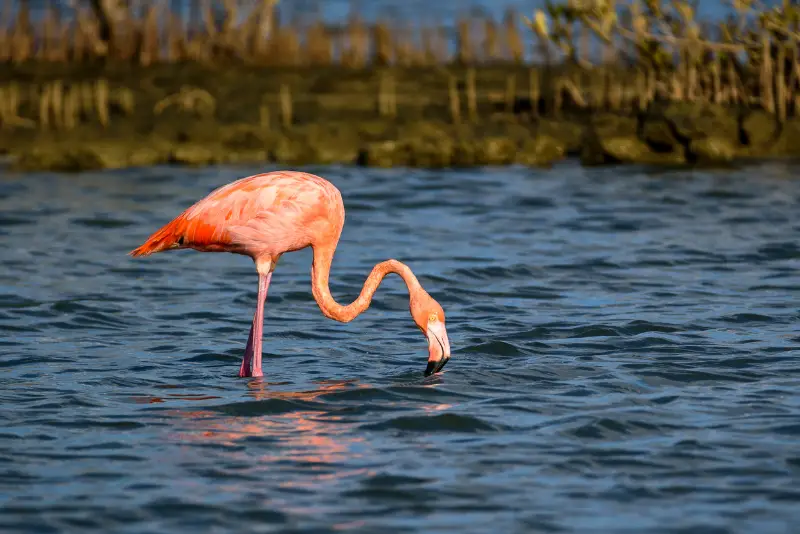
This coastal bird is a member of the flamingo family, Phoenicopteridae, and is found along the coasts of Florida, the Gulf of Mexico, as well as the Caribbean and northern parts of South America.
It is thought that the population of American Flamingos in the United States is descended from birds that escaped from parks and zoos.
It is most commonly seen in the Everglades and other areas in the southeastern United States with salt flats.
Cormorants
Double-crested Cormorant
Scientific name: Phalacrocorax auritus
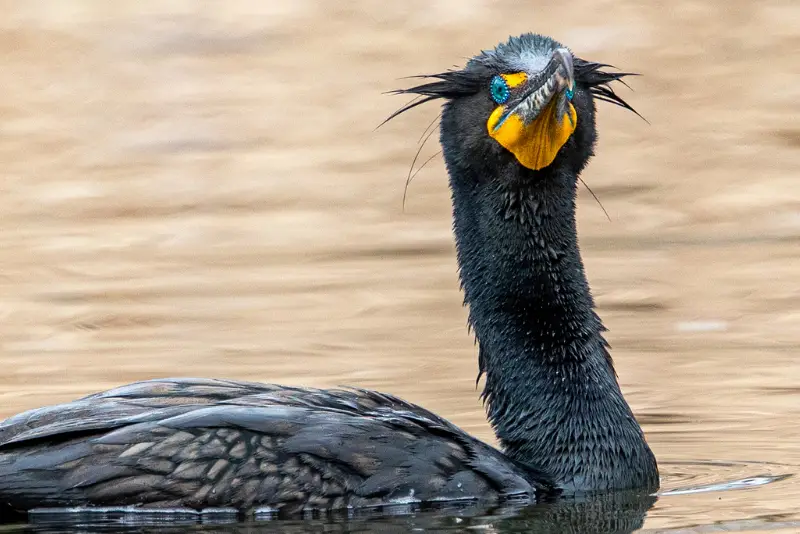
The Double-crested Cormorant is a large, dark aquatic bird with a long neck and blue eyes. It is a year-round resident in North America, and is commonly found on coastal waters of both the east and west coast.
This cormorant likes to gather in large flocks that roost on trees close to water. It is a skilled diver and hunts fish with its large, hooked black bill.
When a group of cormorants flies together, they like to form up in a V shaped formation.
Often these V-shaped formations can be seen in the evening, when the birds fly to their roosting spots.
Skimmers
Black Skimmer
Scientific name: Rynchops niger
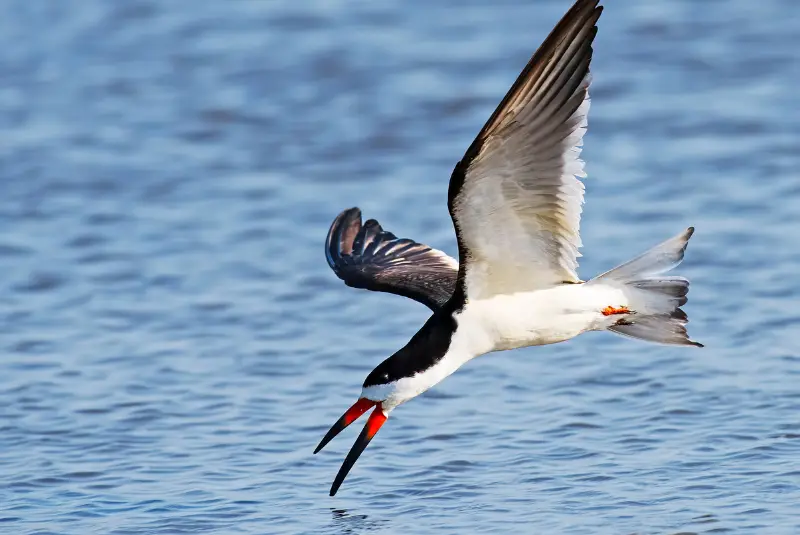
The Black Skimmer is a striking shore bird that is easy to identify both by its appearance and its behavior.
The black upperside contrasts with a bright white underside, and with a long, bright red bill. The lower part of the Black Skimmer’s bill is significantly longer than the upper part.
This skimmer catches fish by flying along the water surface, while pulling its lower bill through the water. When the lower bill encounters a fish, the bill slams shut to catch its prey.
The Black Skimmer is most common along the Gulf Coast and also breeds in several other locations along both the east and west coast.
Pelicans
Brown Pelican
Scientific name: Pelecanus occidentalis

The Brown Pelican is a common water bird along the North American seashore, where it hunts fish by plunging head-first into the water.
Adult Brown Pelicans are grayish brown with a dark belly, and can be easily recognized by their massive bill.
While this pelican species was endangered a few decades ago due to pesticide poisoning, it has now recovered and is once more a common breeding bird and year-round resident.
Final remarks
In summary, here are the 21 types of beach birds in North America covered in this article:
- Laughing Gull
- Herring Gull
- Royal Tern
- Forster’s Tern
- Sanderling
- Spotted Sandpiper
- Black-necked Stilt
- American Oystercatcher
- American Avocet
- Short-billed Dowitcher
- Black-bellied Plover
- Willet
- Whimbrel
- Great Blue Heron
- Tricolored Heron
- White Ibis
- Roseate Spoonbill
- American Flamingo
- Double-crested Cormorant
- Black Skimmer
- Brown Pelican
If you’ve spotted one of these birds, but aren’t sure which species it was, check our detailed ID guide with photos above.
And if you enjoyed this article, check out our guide to the water birds of Florida.
